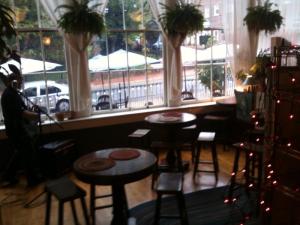Micropolitan Manifesto: A Journey from the Big Apple to Back Home

In 2008, Katie McCaskey made the decision to move from NYC, back home to Staunton, Va., where she could afford to own a house and open a business. Even though Staunton is small, she still enjoys downtown amenities, the town’s historic character and walkability, the same things she loved about urban living. Becoming an entrepreneur hasn’t always been smooth sailing, but the experience has made her a passionate advocate for small towns, ‘micropolitans’ as she calls them, and their potential. She’s written an inspiring manifesto encouraging others to invest in them as she has. She recently shared her discoveries with The HillVille.
By Katie McCaskey
This is the story of how I loaded a shiny .38 for protection, wondered alone into the woods, and sequestered myself in a ramshackle cabin to compose my manifesto on How I Think The World Should Be.
Except: it didn’t happen that way. Not exactly.
It began in 2008. My boyfriend Brian and I wanted to purchase a house. We lived in New York City but decided to invest in Staunton, Virginia (pop. 22,000), the small city in the Shenandoah Valley where I grew up, but hadn’t lived in since I was 11. We initially anticipated that “sometime later” we might move there, but, our timeline advanced the weekend we closed. Upon return to New York the architectural design firm he worked for imploded—a canary in a coal mine of a different sort. Since I telecommuted we figured there was nothing like the present to enjoy our new (albeit built in 1866) home. So we packed. This was a radical move, but nothing like what would come next.
My job required wi-fi so I started working from the nearest coffee shop. We struck up a casual acquaintance with the owners. In a surge of enthusiasm a short time later we partnered with them in a new venture. The business? A neighborhood grocery in the space next door. This was one neighborhood convenience that we previously enjoyed and missed. It seemed like fate because the space had originally been built as a grocery in the 1880s, founded by a New Yorker.
Fate has a funny way of testing you. Imagine trying to control a plane with its wings shot off, flying upside down with the cabin on fire as it barrels headfirst to the ground. It was a disaster. Nearly everything went wrong.Perhaps determined stubbornness is our at our core—his family roots in northern Kentucky—but, we refused to back down or quit. The effort paid off.
George Bowers Grocery, our neighborhood grocery/cafe, recently celebrated its third year in business. We’ve expanded to a new location with a patio beer garden. We happily continue to grow, and thankfully sans former partners.
Vision for the Future
Make no mistake: starting an independent business is not for the timid. During the process I made several seemingly disconnected observations. With time I realized they were all related. Now, I believe they are the keys to a new way forward.
This journey opened my eyes to three things:
1. Our smallest cities (micropolitans) offer the dense, walkable infrastructure coveted by sustainability advocates and overlooked by most urbanists. In fact, prior to the economy’s crash our home’s walkscore in Staunton was the same as our Morningside Heights address in Manhattan—amazing!;
2. Our capitalistic system and economy are evolving. Most small cities understand that job creation isn’t likely to come from outside investment but growth from within. There is increasing popular support of independent businesses (“eat local”, “buy local”) in response to job insecurity, corporate greed, and the need to strengthen and relocalize our economies. Burgeoning grassroots efforts to support independent business are taking new and creative forms, such as community-supported microfinance, which we utilized;
3. Those of us aged 30-45 represent the highest in-migration of people to rural areas. (You might not consider yourself a “rural” resident, but, the term is loosely defined by federal agencies as any city with a population of 100,000 or less.) As a group, we’ve been shown to be an educated and entrepreneurial bunch—and that’s extremely exciting.
So, we’ve got:
1. Places that want and need business investment and revitalization, while already offering the urban benefits of walkability and community-building interactivity (micropolitans)
2. Efforts to encourage and support independent business (microfinance, consumers themselves, and other local intitiatives)
3. People willing and able to redefine and revitalize our smallest cities—(you!)
The “Micropolitan Manifesto” is a call-to-arms for creative entrepreneurs to start businesses in our smallest urban centers, our micropolitans. I believe Appalachia is a wonderful place to start.Building independent businesses will help revitalize and reshape our micropolitans, while emphasizing the existing benefits our smallest cities already offer. Entrepreneurs can work to relocalize our economies, determine their own economic destinies, and enhance the sense of community individuality so lacking presently in Anyplace, U.S.A. Further, I believe urban infrastructure—especially in the smallest context of a micropolitan—contributes to a happier, healthier and more sustainable lifestyle compared to suburban sprawl. Micropolitans have the unique capability to inspire community, define a unique sense of place, and ultimately, a sense of shared purpose.
Read it here and share your thoughts.If you enjoy it, please forward it to someone you think would appreciate it.
 Katie McCaskey returned to her roots in the Shenandoah Valley of Virginia after years of city living. She and her husband operate George Bowers Grocery, a neighborhood cafe/beer garden in Staunton, Virginia. Her first book, “Urban Escapee: How to Ditch the Commute, Build a Business and Revitalize Main Street” will be published this year.
Katie McCaskey returned to her roots in the Shenandoah Valley of Virginia after years of city living. She and her husband operate George Bowers Grocery, a neighborhood cafe/beer garden in Staunton, Virginia. Her first book, “Urban Escapee: How to Ditch the Commute, Build a Business and Revitalize Main Street” will be published this year.










Splendid. I am about to share this, and encourage people to read (or “view”) the Manifesto, which is a fine piece of work.